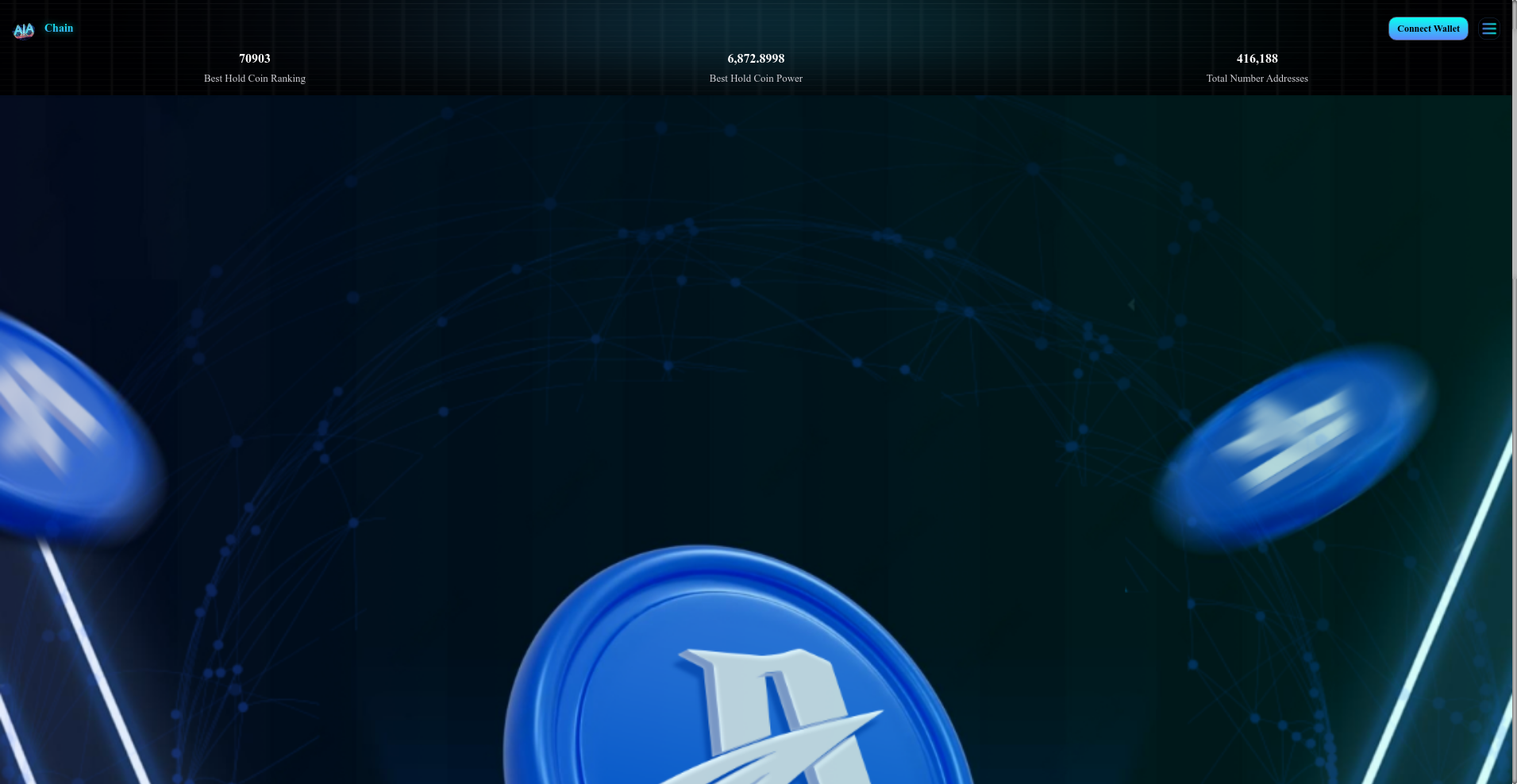AIA Power ($AIA) Review: A Data-Driven Look at Its Legitimacy, Risks, and Long-Term Potential

What Is AIA Power: An Introduction
AIA Power is a blockchain project centered around its native token, $AIA. The platform promotes the collection and promotion of its tokens through mechanisms such as holding, inviting others, and participating in its mining pools. Its core proposition involves a system of "Hold Coin Power," which is calculated through a proprietary algorithm, ostensibly rewarding active participation and community growth.
The project emphasizes integrating a unique consensus mechanism called ISN and encourages users to stake tokens and engage in referral activities to increase their earning potential within the ecosystem. Despite its ambitious goals, an impartial analysis of AIA Power's technological robustness, team credibility, and long-term sustainability is essential before considering it as a serious investment opportunity.
The Team and Roadmap Evaluation
Assessing the team behind AIA Power is challenging, as the available information provides limited details about individual founders or core developers. There are no publicly available biographies or easily verifiable prior experience of team members. While the project maintains a community presence on Telegram with over 3,350 members, this does not necessarily enhance credibility without further transparency.
Below are key milestones from their roadmap, taken from the project documentation:
- Smart Contract Audit: Completed in December 2024, assessing the staking and governance contracts. This relates to the broader topic of smart contract vulnerabilities.
- Community Growth Initiatives: Ongoing marketing campaigns and community engagement efforts are reported, but concrete timelines are sparse.
- Protocol Upgrades: Promised future proposals for system upgrades, but specific dates or technical specifications are not provided. This touches upon the complexities of upgradeable smart contracts.
- Integration of Consensus Mechanism: Aiming to implement ISN consensus, with a completed introduction and explanation of its functionalities.
Overall, while the project demonstrates a strategic plan, the lack of clear team transparency and concrete technical progress makes it difficult to confidently assess their capacity to deliver on promises. The roadmap appears aspirational with some progress evident, but the absence of visible developer credentials warrants caution.
Assessing the Security and Integrity of AIA Power
Based solely on the available Cyberscope audit report, AIA Power's smart contract security posture indicates a relatively high score of 95.99 out of 100, which signifies favorable security attributes. Nonetheless, the audit reveals some notable concerns in the contract's complexity and maintainability, as discussed in our guide to understanding complex audits.
Key findings include:
- Contract Complexity: The smart contract code was described as "overly complicated, tangled, and deviating from standard coding principles." Such complexity increases the risk of bugs and vulnerabilities, especially if the codebase remains unwieldy and difficult to audit thoroughly.
- Ownership and Upgradeability: The system uses an upgradeable architecture via the Proxiable pattern, granting administrators the ability to modify the contract logic. While flexible, this centralization of upgrade rights could pose security and trust risks if not properly managed.
- Role Management: A clear ownership and administrative hierarchy is implemented, with comprehensive logging. However, the control remains largely in the hands of administrators, which could be exploited if governance is not robust.
In conclusion, the audit presents a generally positive security score, but the highlighted code complexity and the reliance on upgradeability mechanisms imply that potential investors should remain cautious. Effective governance and ongoing code audits are essential to mitigate long-term risks.
A Breakdown of AIA Power Tokenomics
The economic model of AIA Power appears centered around token holding, referral promotion, and mining-like mechanisms. The available data demonstrates a complex structure designed to incentivize active participation, but also raises questions about its long-term sustainability.
- Total Supply: Not explicitly provided; references to total hold amounts suggest a large or circulating supply, but precise figures are absent.
- Distribution & Allocation:
- Team & Advisors: No specific allocation percentages or vesting schedules are disclosed.
- Community & Ecosystem: No detailed data on community rewards, staking incentives, or developer allocations.
- Vesting & Release Schedule: Not detailed; the lack of transparent vesting could imply centralization of token holdings early on.
- Utility & Incentives: The token's primary utility lies in holding, promoting, and participating in mining pools, granting "Hold Coin Power" that impacts rewards.
- Economic Risks: The absence of clear tokenomics, combined with the complex algorithmic incentives, may lead to ecological imbalances or hyperinflation if the system scales rapidly without proper controls.
Overall, while the mechanics suggest an incentivization framework designed to grow both user base and token circulation, the lack of detailed, transparent economic parameters makes assessing sustainability difficult. Holders should remain vigilant for potential inflationary pressures and centralization risks.
Assessing AIA Power's Development and Ecosystem Activity
Based on the available updates, AIA Power demonstrates some initiative in advancing its platform. The completion of smart contract audits and public documentation point towards a development trajectory focused on transparency and security.
Community engagement via Telegram and social media indicates ongoing efforts to grow the user base; however, independent verification of the project’s development milestones or real-world integrations remains limited. Most updates seem to be marketing in nature, with little visible evidence of substantial technological progress or partnerships.
Typically, projects with genuine traction demonstrate active GitHub repositories, frequent code commits, or beta releases. Such data is not publicly evident for AIA Power, raising questions about the project's current progress beyond promotional announcements.
What Investors Should Know About AIA Power's Terms
Examining the project's legal and operational framework, the available documentation does not specify unusual contractual clauses or risky legal terms. The platform’s reliance on smart contracts and upgrade authority does introduce centralization concerns, but nothing explicitly problematic emerges from the available information.
Potential investors should scrutinize the following cautionary points:
- Upgradeability Control: The ability of administrators to modify the smart contract could be exploited if not properly governed.
- Lack of Transparency: Limited disclosure on token allocation, vesting, and governance mechanisms increases the risk of undisclosed centralization.
- Community and Legal Compliance: As with many crypto projects, the absence of clear legal frameworks or jurisdictional disclosures warrants caution.
Given these considerations, potential investors should seek more comprehensive legal documentation and monitor governance practices closely.
Final Analysis: The Investment Case for AIA Power
In summation, AIA Power presents itself as a community-driven platform emphasizing holding, promoting, and mining variously calculated through proprietary algorithms. Its high security score and the completion of an audit are positive indicators. However, several red flags remain, primarily centered around the project's opacity regarding team credentials, complex and convoluted smart contracts, vague economic parameters, and limited visible development activity.
Pros / Strengths:
- High security audit score (approx. 96%), indicating robust technical safeguards.
- Implementation of upgradeable smart contracts, allowing system evolution.
- Active community presence, which aids in network effects.
- Innovative "Hold Coin Power" mechanism, designed for community engagement.
Cons / Risks:
- Limited team transparency and verifiable credentials.
- Overly complex, non-standard smart contract code, increasing maintenance and security vulnerabilities.
- Vague and undocumented tokenomics, raising sustainability questions.
- Potential centralization in governance and upgrades, which could pose future risks.
- Limited evidence of active technological development or partnerships.
While the project offers promising features for community engagement and rewards, the current opacity, code complexity, and absence of clear long-term economic viability suggest that potential investors should exercise caution. A thorough due diligence process remains vital, and if considering participation, doing so with an awareness of the outlined risks and uncertainties is advisable.

James Carter
Chief On-Chain Analyst
On-chain analyst with a background in financial fraud detection. I use data science to dissect blockchains, find the truth, and expose scams. My motto: code doesn't lie.
Similar Projects
-
Kima Network
Kima Network Review: Is This Crypto Project a Scam? Crypto Scam Checker & Analysis
-
Avante (AVAXT)
Review of Avante (AVAXT): Is This Crypto Project a Scam or Legit?
-
Render Token
Render Token Review: Scam Check & Legitimacy Analysis
-
ActionX
Crypto Scam Checker: ActionX Project Review & Risk Analysis - Is It a Scam?
-
Tranche Finance
Tranche Finance Review: Scam Check & Legitimacy Analysis